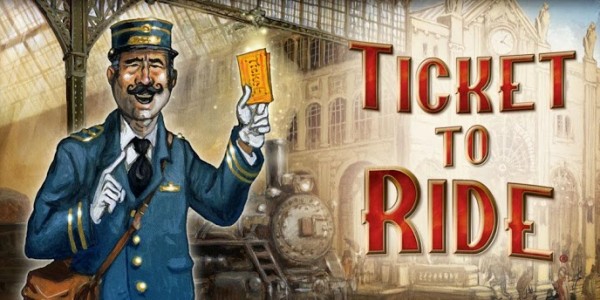 Ticket to Ride for iOS is proof that parallel universes really do exist. While America’s best and brightest are bent over their game tables, cleverly hoarding cards and laying routes, a dedicated community of Ticket to Ride Appsters is perfecting its craft. This digital universe of tickets and trains, inhabited by players of all ages and nationalities, is not only governed by advanced tactics and strategies, but a code of etiquette all its own. But before we get to the juicy bits—the politics and intrigue of laying cyber tracks—let’s talk about the app itself. For starters, there are two iterations, Ticket to Ride Pocket and Ticket to Ride, the full version.
Ticket to Ride for iOS is proof that parallel universes really do exist. While America’s best and brightest are bent over their game tables, cleverly hoarding cards and laying routes, a dedicated community of Ticket to Ride Appsters is perfecting its craft. This digital universe of tickets and trains, inhabited by players of all ages and nationalities, is not only governed by advanced tactics and strategies, but a code of etiquette all its own. But before we get to the juicy bits—the politics and intrigue of laying cyber tracks—let’s talk about the app itself. For starters, there are two iterations, Ticket to Ride Pocket and Ticket to Ride, the full version.
TTR Pocket is a decent option for the sporadic player. TTR Pocketeers can play against other in-network players and go head to head with online competitors. The key downside of TTR Pocket is that it only includes the United States map. This might suffice for more casual players, but for diehard TTR Appsters this might be a frustrating setback; it prevents you from initiating or joining online games with any map other than the original. This can seriously limit the number of online transcontinental duelists with whom you can match wits, but there is a loophole that allows TTR Pocket players to join full TTR games on the expansion maps if invited directly by a buddy who has purchased the expansion in question, so all hope is not lost.
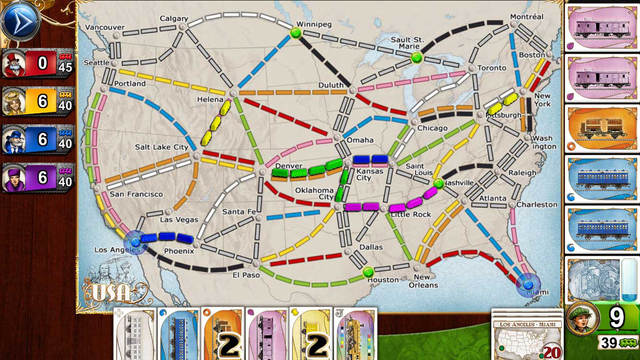
The full version, however, opens the door to train wonderland. If one is willing to pay the modest price for upgrade, one has access to the full panoply of international boards (save United Kingdom, Pennsylvania, and Africa). For those less familiar with the Ticket to Ride game series, this includes the United States, Switzerland, Asia, India, and Europe. The cyber expansion packs are certainly more financially savvy than purchasing each of the real-world versions. Luckily, there’s no need to put cash on the line for the United States expansions: 1910, Mega, and Big Cities come complementary with the full version of the game. But if you’re in the market for the full smorgasbord, it’s most economical to buy the full version straight away for $9.99.
Additionally, the full version of Ticket to Ride includes the much-loved Single-Session multiplayer mode, which requires games to be attended for the full duration of the competition. TTR Pocket is limited to the asynchronous Multi-Session mode, which is, again, more suitable for the casual player or anyone on the go with intermittent data coverage or other reasons for interruption mid-game. Multi-Session games are, of course, included in the full version, as well.
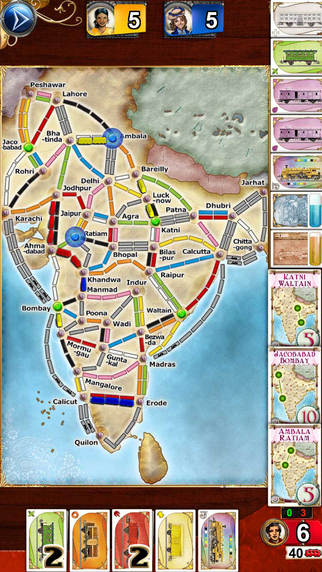 Given the elegant simplicity of the real-world game, it should be no surprise that it translates beautifully to iOS or Android. Apart from the unsettlingly disproportionate illustrations on the original board (a swordfish of mammoth proportions, a trio of travelers the size of Texas), the app version is an exact replica. For neat freaks, the app even has some particular advantages: the draw pile and tableau of face-up cards are always perfectly kempt. Players’ hands are equally clear. One’s cards appear at the bottom of the screen. The clutter of card hoarding is conveniently reduced; instead of showing each individual card a player possesses, the game superimposes a number on each colored stack, indicating how many of that color a player has managed to collect.
Given the elegant simplicity of the real-world game, it should be no surprise that it translates beautifully to iOS or Android. Apart from the unsettlingly disproportionate illustrations on the original board (a swordfish of mammoth proportions, a trio of travelers the size of Texas), the app version is an exact replica. For neat freaks, the app even has some particular advantages: the draw pile and tableau of face-up cards are always perfectly kempt. Players’ hands are equally clear. One’s cards appear at the bottom of the screen. The clutter of card hoarding is conveniently reduced; instead of showing each individual card a player possesses, the game superimposes a number on each colored stack, indicating how many of that color a player has managed to collect.
Destination cards sit just to the right, forming a virtual pile that can be shuffled through click by click. When a player is ready for new destination cards, he taps his destination deck and out slides a cute little ticket with a plus sign. Clicking on the plus sign and confirming one’s desire to accept new destination tickets earns a spread from which to choose. On the far right is a player’s master panel, complete with avatar, screen name, score, and remaining trains. Clicking on opponents’ panels allows one to see how many destination tickets, trains, and cards she has (although once a player amasses more than eight card, it reports only “8+”).
The Ticket to Ride mobile game offers some key advantages over the real-life game. The original is perfect for leisurely, lighthearted games with friends and family. The app is the better bet for those deft of mind and quick of finger. It successfully streamlines game mechanics, allowing players to draw cards and lay trains in a fraction of the time it would take in real life. I recently played a modestly paced, real-life, four-player game in my living room that took almost two hours. In contrast, a four-player game on my phone takes me approximately thirty minutes. Of course, the online version pales in comparison when it comes to playful banter, poker faces, and showboating. But it’s still surprisingly social.
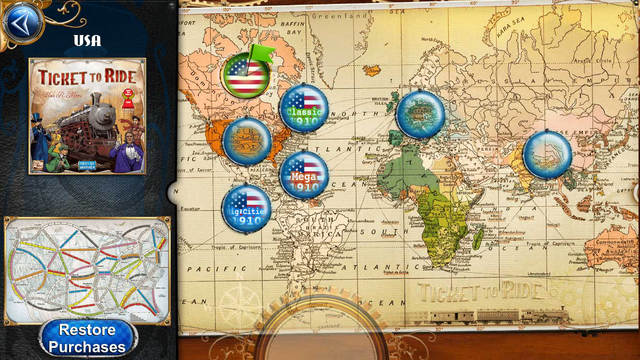
Ticket to Ride is also delightfully cosmopolitan, although English is (as one would expect) the default language in all games. Players can message each other in various ways during matches and when waiting in the digital “lobby.” I’ve started many a game with a friendly “Hi!” or waving avatar from my opponent. In one game, we joked while we stumbled all over each other to build trains, having all chosen destinations tickets in the Midwest. In a bizarre move, a Dutch opponent hit on me. Laments about bots (which replace you when you leave a single-session game or—gasp—when your app momentarily crashes) are common: They tend to use cards frivolously.
Now for the juicy bits! Ticket to Ride is governed by a simple yet serious system of etiquette. Intentional blocking is considered generally in poor taste. Intentional blocking is more than just annoying; defensive play suggests a lack of tactical skill. Players will specify their block preferences in their game titles. “NO BLOCKING,” is a common theme, “no intentional block!” is another. Conversely, cutthroat competitors ominously warn “anything goes.” Slowpokes are also disfavored. Game times can be capped, with each player afforded a specific number of minutes (my sweet spot is nine), and bots replace those who unwisely run down the clock. Players are also known to pointedly display yawning avatars when an opponent seemingly vanishes mid-game (or mid-turn).
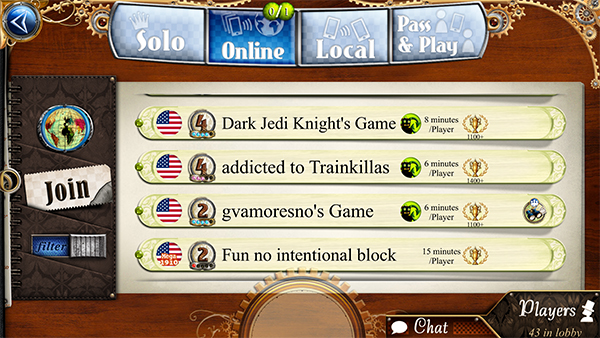
Lastly, those in the community who care about ranking tend to be strict about it. Many games request players above or below a certain ranking. I once entered a 1350+ game with a lower ranking and was promptly chided by the creator. He begrudgingly played me anyway. However, on the whole the community is generally amicable and skilled. I’ve had players praise me for “good form” or congratulate me on a “good game.” It’s a nice feeling to have one’s train-building skills validated by a friendly stranger from halfway across the world.
In sum, Ticket to Ride should be freely and highly recommended to any and all interested parties, with TTR Pocket an acceptable first step for the less enthusiastic. The interface is easy to use and a consummate replica of the original. The ability to play strangers and invite friends to private games means you’ll never be stuck without a partner. But be careful. The game is most definitely a hindrance to personal productivity. One player’s username says it all: TrainAddict.




